
Churches and Cathedrals of Manhattan, New York City - 6
Personal notes and information gleaned following a visit October 2003, and features only the churches which I discovered during my seven days in New York. The churches face in all sorts of directions, the descriptions that follow therefore have ritual directions which assumes the high altar is at the east end of the building. The churches are all Roman Catholic, unless otherwise mentioned, and are featured in the order I visited them.
AROUND GROUND ZERO
Our Lady of the Rosary and Shrine of St Elizabeth Ann Seton ( 7 State Street)
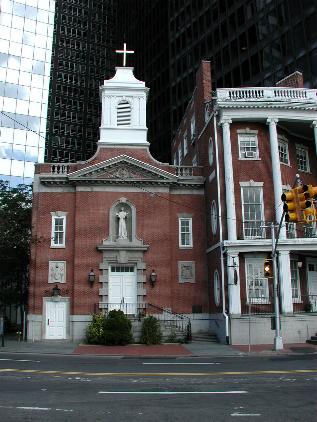 |
Close to the southern tip of Manhattan,
opposite Battery Park and the Staten Island Ferry
terminal, this church was built in 1883 alongside the
house where Elizabeth Ann Seton (1774-1821) lived from
1801-03. Mother Seton founded the American Sisters of
Charity, the first order of nuns in the USA, and she in
turn became the first native-born american to be
canonised by the Catholic church. After the Civil War the
Mission of Our Lady of the Rosary tuned the house into a
centre for homeless Irish immigrant women and 170,000
women have passed through its doors. The order
established and maintains the shrine of Mother Seton. The church is small and quite irregularly shaped, and dwarfed by the massive office buildings of Lower Manhattan. It is in a Colonial Classical style and has galleries on three sides. Its date my surprise you, being built in 1964 to the designs of Shanley & Sturges. I found the church open. |
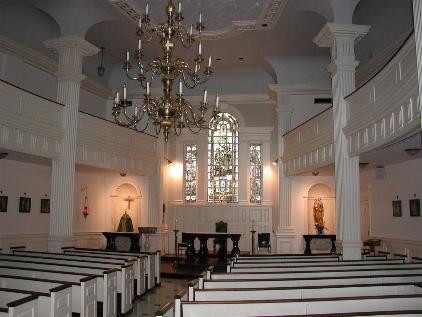 |
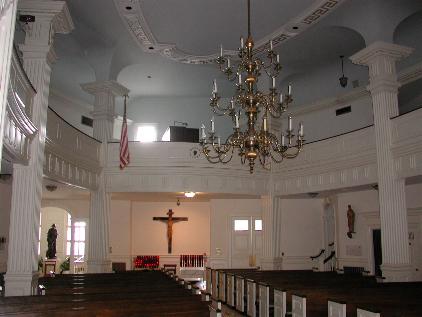 |
Trinity Church (Episcopal) (Broadway and Wall Street)
| Perhaps New York's most famous church,
largely because of its dramatic situation at the head of
Wall Street. Sadly this view on the day I was here was
partially obscured by scaffolding on buildings in Wall
Street. The first church was built in 1697 but burned in 1776 during the British Occupation and remained in ruins until after the granting of independence when the second church was built. This had to be demolished in 1839 after a heavy fall of snow compromised its roof. The present building to the designs of Richard Upjohn was completed in 1846. The 280ft (86m) high spire was the tallest building in the city at the time. The style is English Perpendicular with a west (actual east) tower, nave and aisles and chancel of full height of tow bays seperated by a cross arch. The windows have transoms, including the fine seven-light east window. The All Saints Chapel was added in 1913 (architect Thomas Nash) to the south of the vestry passage and seperated from it by a highly ornate tomb to ?Rev. Dr Morgan Dix, rector here 1862-1908, with effigy on tomb chest under an elaborate canopied superstructure. On the opposite side of the chancel a small museum has also been added. |
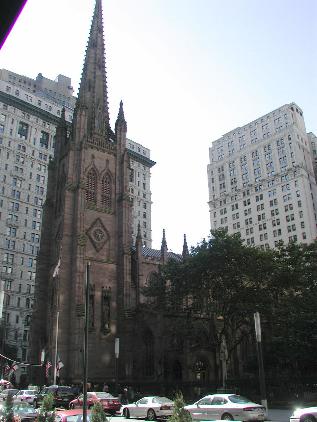 |
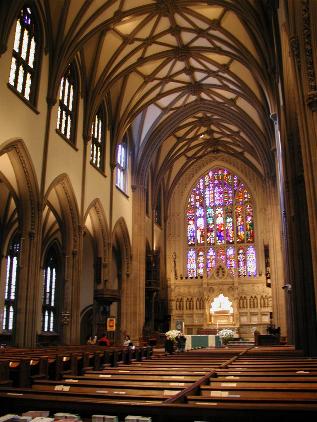 |
The interior is given added grandeur by the
lierne vaults, which are actually of plaster and
suspended from a wooden roof, but appear quite
convincing. The arcades too are embellished by a carved
band of foliage in the mouldings of the arch. The west gallery and organ case are Upjohn's design too, although the organ itself has been rebuilt and extended many times. I found the church open. |
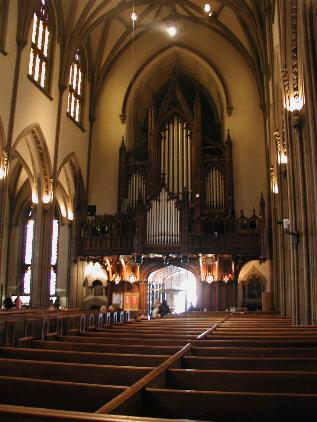 |
St Paul's Chapel (Episcopal) (220 Broadway, between Fulton Street and Vesey Street)
 |
It is astonishing that the church still
stands, as it is directly alongside the World Trade
Centre site now known as "Ground Zero." The
church played an active part in servicing the rescuers of
the many months that followed September 11th 2001.
Apparently trees in the churchyard facing Church Street
helped save the building from falling debris. The
interior retains exhibits and mementos from this period,
including scratches on the white painted pews made by
fire-fighters equipment as they grabbed a few hours sleep
between duties. The church was completed in 1766, a chapel-of-ease to Trinity Church. At the time of construction it stood facing fields. The architect was Thomas McBean. The steeple was added in 1794 to the designs of James Crommelin Lawrence. The church is correctly orientated, but the protico stands facing Broadway and shelters the sanctuary. |
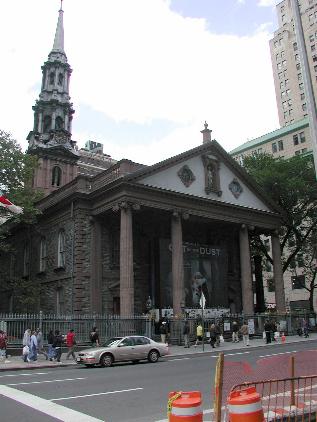 |
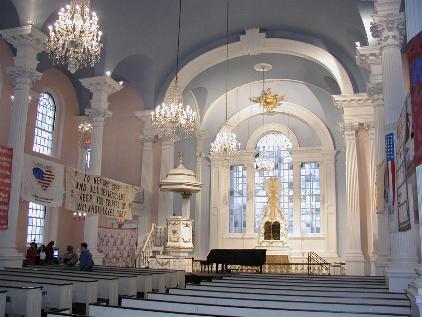 |
The interior is a beautiful example of Georgian architecture. It has galleries on three sides. Many of the fittings predate the Revolution, and the Prince of Wales feathers can be seen above the pulpit. | 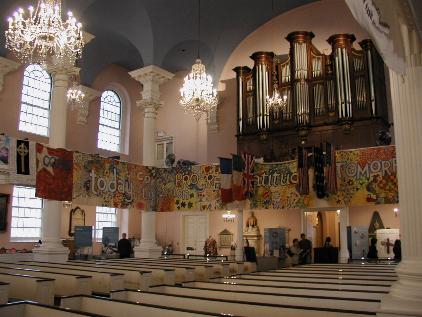 |
I found the church open, and a moving memorial to September 11th 2001.
St Peter (22 Barclay Street / Church Stret)
 |
This was the first Catholic church in New
York, and sadly I found it locked. It is one block away
from Ground Zero (trees on the far right of the
photograph are in St Paul's churchyard) and survived the
collapse of the towers. The church roof was damaged by
the landing gear from one of the planes which hit the
World Trade Centre's twin towers and the body of the Fire
Chaplain Fr. Mychal Judge was brought here from the north
tower to rest in front of the altar. The building dates from 1836-38, the second church on this site (purchased from Trinity Parish in 1785) and was designed by John Haggerty and Thomas Thomas. It has an impressive granite portico with six Ionic columns. |
<BACK> <MANHATTAN INDEX> <NEXT>
page updated 27th March 2005